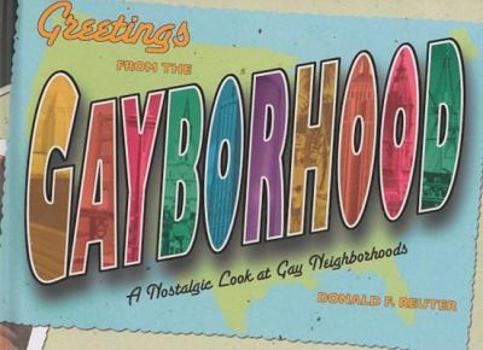Greetings from the Gayborhood: A Nostalgic Look at Gay Neighborhoods
From the Castro to Chelsea, Greetings From the Gayborhood , celebrates twelve traditionally gay neighborhoods in America, past and present. Featuring archival images along with nostalgic and sometimes kitschy ephemera (bar ads, event programs, matchbooks, flyers, and more) this scrapbook-style collection is the perfect souvenir for where the boys are and were. Donald F. Reuter has chronicled the evolution of gay neighborhoods in twelve cities--Atlanta, Boston, Chicago, Fort Lauderdale, Los Angeles, New Orleans, New York City, Philadelphia, San Diego, San Francisco, Seattle, and Washington DC--and studied how gentrification has affected them and their role in the greater community. Greetings From the Gayborhood is a spirited and sexy time capsule that celebrates the history, creativity, and longevity of gay America.
Format:Hardcover
Language:English
ISBN:0810995409
ISBN13:9780810995406
Release Date:June 2008
Publisher:Harry N. Abrams
Length:128 Pages
Weight:0.75 lbs.
Dimensions:0.8" x 5.5" x 7.3"
Age Range:13 years and up
Grade Range:Grade 8 to Postsecondary
Customer Reviews
2 ratings
A must have
Published by Thriftbooks.com User , 16 years ago
Donald F. Reuter is a gifted writer and a very talented illustrator. Always with his pulse on gay America Mr. Reuter has hit another home run with "Greetings from the Gayborhood". For those of us who lived through these changes in neighborhoods, it's a walk down memory lane. For those who are currently experiencing them, it's a valuable, historical look at the important role gay culture has played in the changing landscape of America. This is a must have for every gay American, or anyone interested in pop culture.
Remembering
Published by Thriftbooks.com User , 17 years ago
Reuter, Donald F. "Greetings from the Gayborhood", Abrams Image, 2008. Remembering Amos Lassen Remember when there were actual neighborhoods where gay people lived? There was the French Quarter in New Orleans, the Castro and New York City's Greenwich Village among others. Donald Reuter looks at those "gayborhoods" all across America and gives us their stories through photographs, images from archives, nostalgia and some very naughty little anecdotes. He gives us looks at twelve different American cities and the neighborhoods where the gays lived and in some cases still live. The book is postcard-sized and it is a little scrapbook which is a great souvenir of gay living. "Gayborhoods" are enclaves that came into being because of shared interests--be they social, economic, political, moral, geographical or what have you. There was a time when we needed to be together because there was safety in numbers. Today the very same factors that brought about their creations are what are causing them to fall apart. "Gayborhoods" were where we went to celebrate our sexuality and be ourselves without having to answer to anyone. The "gayborhoods" became even more distinct with the white-flight to the suburbs and in some cases, downtown areas fell into our hands. This coupled with the fact that gay men know how to survive and we were able to make difficult situations better. We began to gentrify the slums and build our lives. It was between the 60's and the 80's that "gayborhoods" came into their own. Some of the things to notice about "gayborhoods" is that they were usually located near to where the inhabitants worked and played and other points of interest like parks, universities and hospitals are nearby. Many times we are located "on the wrong side of the tracks" and the railroad served as a line of demarcation. Nothing was separated by great distance. For example in New Orleans, most of the gay bars are within walking distance of each other and the residences are nearby as well. We usually decorate our neighborhood so that other will know it is a "gayborhood". I love this book. It is just fun to read and look at. I must admit that the section on New Orleans made me misty. Remembering the My-Oh-My Club reminded me of those days in high school when everything was said in whispers and as I write this I am longing for coffee and beignets from Café du Monde. Little Rock, Arkansas is very, very different from the French Quarter and as wonderful as the memories are, I think we are probably better off by not being restricted to live in "gayborhoods". They were great but we have come a long way yet we need to give Donald Reuter a thank you for taking the time to remind is when "the friends of Dorothy" lived behind their rainbow colored walls.





